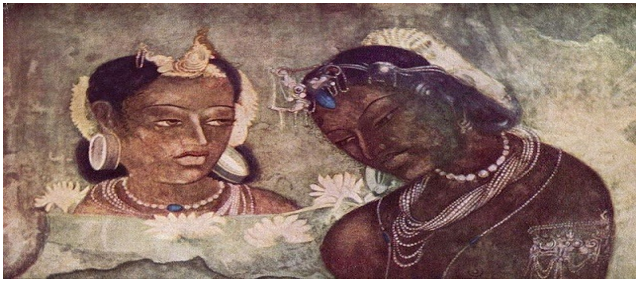Mentioned under the syllabus of General Study’s paper I for UPSC Civil Services Mains, Indian Art and Culture is one of the core areas of UPSC to ask questions. Although, UPSC syllabus related to “ Art and Culture” mentions only in just one line “Salient features of Literature, Art Forms, and Architecture from ancient to modern times”. However, going through the previous year question papers, one can easily list down important micro-topics that should be studied for Art and Culture syllabus for UPSC preparation. Under Art and Culture Component, painting is one of the important area from which UPSC ask questions. ‘Painting’ topic is important to be studied while preparing for UPSC IAS examination as questions from these topics are static in nature, which don’t change from time to time. Hence, just by putting extra effort to understand the delicate words and identifying the differences in paintings, one can easily solve the questions.
Since ancient times, the tradition of paintings has been carried on in the Indian subcontinent. With the passage of time, Indian classical paintings evolved due to the blending of the various customs, rituals and traditions influencing them. Indian paintings provide an aesthetic continuum that extends from early civilization till present day. Painting is one of the most delicate forms of art giving expression to human thoughts and feelings through the medium of line and colour.
Categorization of Paintings:
After carefully analyzing syllabus of the UPSC, aspirants should shift to the second part i.e. categorization of paintings for their own feasibility in terms of understanding and solving the questions related to painting areas. It is important that aspirants should go for categorization of paintings as these small steps can help aspirants in easily remembering the key differences between different paintings:
- Time Period Specific Paintings (Ancient- Medieval- Modern)
- Region-specific Paintings (PATTACHITRA PAINTING – ORISSA, PITHORA PAINTING – GUJARAT)
- Religion specific paintings (Indo- Islamic painting, Buddhist, Jainism Painting)
- Tribal Painting (Bhil painting, Warli painting, Gond painting)
In modern times, Paintings are divided into five genres:
- History painting
- Religious painting
- Genre painting
- Landscape
- Portrait
Pattern of Asking Questions:
Aspirants should analyze the previous year question papers before starting preparation of art and Culture portion. Previous year question papers can help aspirants in understanding the pattern of asking questions along with which all areas they need to target during the preparation. Generally, UPSC ask questions like:
|
Direct Question ( Specific Word Based) |
Statement Question(Analytical Based) |
|
Q. Which of the following paintings are also popularly known as Snake paintings? a) Guler Paintings b) Basholi Paintings c) Manjusha Paintings d) Kangra Paintings |
Q. Consider the following statements with reference to Madhubani paintings:
Which of the given statements is/are correct? a) 1 only b) 2 only c) Both 1 and 2 d) Neither 1 nor 2 |
Approach of Covering Painting Topic:
While covering Indian Art and Culture portion, aspirants find it difficult to manage the entire syllabus as art & Culture portion is not only difficult to understand but, it has also vast syllabus. During the preparation of Painting portion, aspirants should have the ability of analytical thinking. . Questioning is the most crucial component for developing the thinking pattern on topics and hence learning the deep-rooted and hidden meaning associated with concerned painting.
Why?
- Painting is one of the most delicate forms of art giving expression to human thoughts and feelings through the medium of line and colour.
- The rocks have been painted by the cave dwellers to satisfy their aesthetic sensitivity and creative urge.
- Paintings in India was started in the ancient period, since the pre-historic era, which evolved in gradual manner with the progress of humanity. Thus, painting is associated with human progress.
- The painting history has originated from rock paintings and carried through pottery, in textiles, miniature paintings and finally with modern paintings. This shows, gradual evolvement of human thinking.
- The diversity in the style of paintings in different parts of the country indicates the diversity in culture as culture and livelihood being the themes of paintings and later dominated by Religion.
- Paintings in India projects the Spiritual contents, high ideals and common belief of the people
How?
Aspirants should bifurcate the areas which they will cover and in which all phases they will cover. For Example, aspirants should start with NCERT books for base foundation and once they have clarity on NCERT topics they can move to standard books. Ask, question by yourselves, like why paining came into life of humanity and how paintings evolve.
- The major inspiration for paintings in India was the birth of three religions – Hinduism, Buddhism and Jainism.
- The major influence has been the deep-rooted history, culture and foreign races, etc.
Source to Cover Painting Topics:
History textbooks of Class VI and VII and XI and XII (NCERTs) cover ancient and medieval history topics that should be studied for building a strong foundation. Apart from that fine arts textbook of Class XI should be studied in detail for the art (Painting) specific questions.
Utilize online resources; For Preparing Indian paintings for UPSC, Follow the official website of CCRT(Centre for Cultural Resources & Training) for all the important updates, pib website for information on GI tags, and other important information on recent cultural festivals and programs.
Booklist for preparing Indian Art and Culture for UPSC:
- NCERT History- Class VI and VII and Class XI and Class XII
- NCERT Fine Arts - Class XI
- Indian paintings, GS SCORE Prelims Sampoorna Fact files
- Newspapers (The Hindu), Monthly Current Affairs, India Year Book
- Website - ccrt.gov.in
Related Articles



